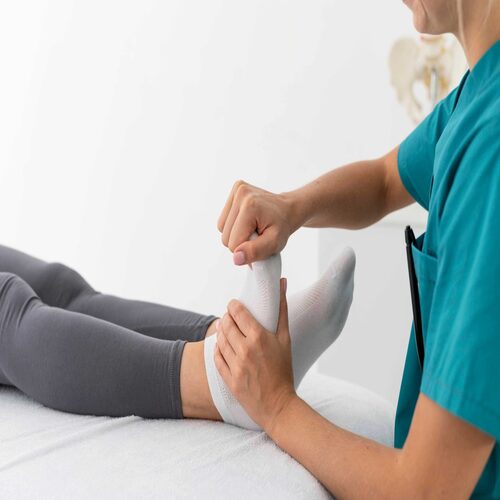Plantar fasciitis is a common cause of heel pain. It occurs when the plantar fascia, a thick band of tissue running along the bottom of your foot, becomes inflamed. This often leads to sharp, stabbing pain, especially when taking the first steps in the morning or after sitting for a while.
Fortunately, most cases of plantar fasciitis can be treated with simple methods. In this article, we’ll explore the treatments that can help reduce pain and improve mobility.
What Causes Plantar Fasciitis?
Plantar fasciitis occurs when the plantar fascia gets overstretched or irritated. The main causes include:
- Overuse or repetitive stress: Activities like running, standing for long periods, or jumping can stress the plantar fascia.
- Poor footwear: Shoes without good arch support or cushioning can contribute to the condition.
- Age: People between the ages of 40 and 60 are most affected.
- Obesity: Extra weight puts more pressure on the feet.
- Foot structure: Conditions like flat feet or high arches can cause abnormal strain on the plantar fascia.
Common Symptoms of Plantar Fasciitis
The main symptom is pain in the heel, especially when you first get out of bed or after sitting. Other symptoms may include:
- Stiffness or tightness in the bottom of the foot
- Swelling or tenderness at the heel
- Pain that worsens after standing or walking for long periods
- Pain that gets better with movement but returns after rest
Basic Treatments for Plantar Fasciitis
Here are some simple, non-invasive treatments that can help reduce pain and promote healing:
- Rest and Activity Modification Resting your foot is the first step in treating plantar fasciitis. Avoid activities that stress the foot, like running or standing for long periods. Giving your foot time to heal is crucial.
- Ice Therapy Applying ice to the heel can reduce inflammation and numb the pain. Try applying an ice pack or a cold compress for 15-20 minutes several times a day, especially after activity.
- Stretching Exercises Stretching the foot and calf muscles can relieve tightness and reduce stress on the plantar fascia. Some useful stretches include:
- Calf stretches: Stand with one leg forward and the other leg extended behind. Press your back heel into the ground to stretch the calf.
- Plantar fascia stretch: Sit down and cross one leg over the other. Pull the toes of the affected foot toward the shin to stretch the bottom of the foot.
- Achilles tendon stretches: Stretch the Achilles tendon and calf muscles to reduce strain on the foot.
- Proper Footwear Shoes with good arch support and cushioning can help relieve pressure on the plantar fascia. Avoid flat shoes or high heels. You might also benefit from custom insoles or arch supports.
- Over-the-Counter Pain Relief Nonsteroidal anti-inflammatory drugs (NSAIDs), such as ibuprofen, can help reduce pain and swelling. These should be used only for short periods.
- Night Splints Night splints keep your foot in a stretched position overnight, which can help reduce morning pain and stiffness. Wearing them while you sleep may prevent the plantar fascia from tightening as you rest.
Advanced Treatments for Persistent Pain
If you don’t find relief with the basic treatments, your doctor may suggest other options:
- Physical Therapy A physical therapist can teach you specific exercises to strengthen your feet and legs, improve flexibility, and correct any walking issues. This can help reduce pressure on the plantar fascia and improve mobility.
- Corticosteroid Injections In some cases, an injection of corticosteroids can reduce inflammation and provide pain relief. These are used sparingly, as repeated use may have side effects.
- Shockwave Therapy This treatment uses sound waves to stimulate healing in the plantar fascia. It can be effective for people who haven’t responded to other treatments. Shockwave therapy helps increase blood flow and tissue regeneration.
- Surgery Surgery is only considered if the pain lasts for over a year and does not improve with other treatments. Surgical options can include removing damaged tissue or releasing tension in the plantar fascia.
Conclusion
Plantar fasciitis can be painful, but with the right treatment plan, most people find relief. Early treatment, such as resting, stretching, and using proper footwear, can reduce pain and help the fascia heal. For more severe cases, physical therapy, injections, or shockwave therapy may be needed. Surgery is rarely required and is usually a last resort.
With the right care, you can reduce pain, improve foot function, and get back to your daily activities.
Read more : https://theguestblogs.com/


